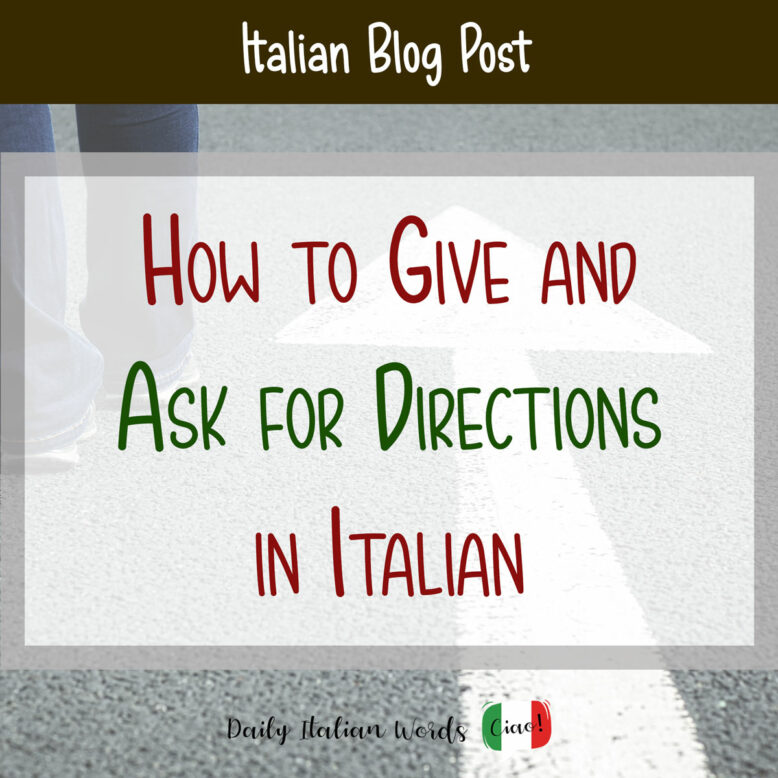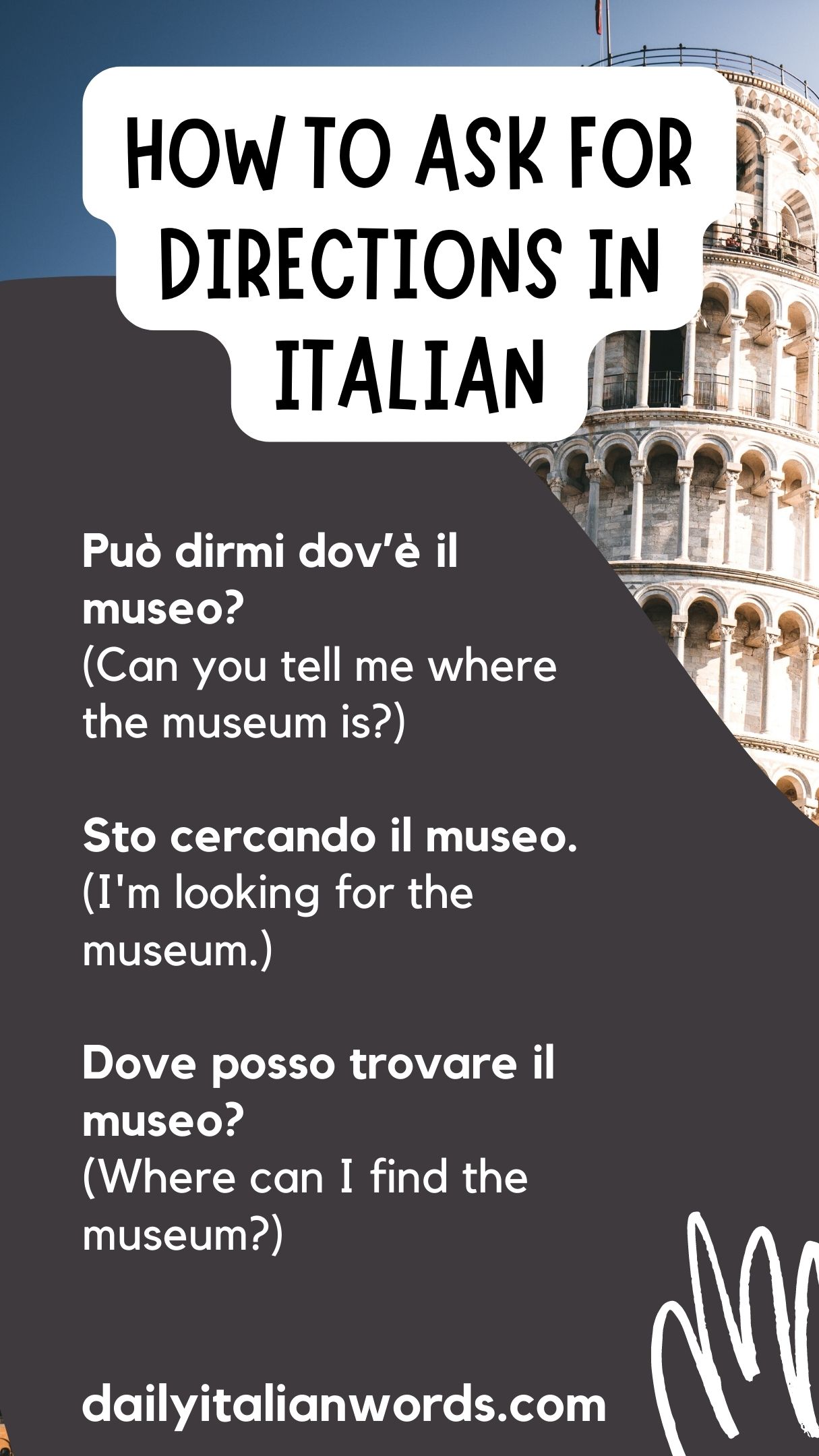Once upon a time, tourists used to ask for directions in order to find their way through a foreign city, and the guidance and suggestions of locals were invaluable when looking for a museum or trying to figure out how to get to the train station on time. But even today, despite GPS technology and step-by-step directions from digital maps and apps of all kinds, nothing beats having a local confirm that the museum entrance is just a few steps away, or that we are catching the right bus in the right direction. Besides, asking for directions is a great way to engage with locals and practise your language skills!

First of all, the basics. Scusi or Mi scusi (Excuse me) is the best way to attract the attention of a passer-by in a polite way before you actually start asking for directions in Italian. If he or she is about your age or younger, the more informal Scusa! will suffice. Italian has two levels of politeness, tu and Lei, but it is highly unlikely that someone will get upset if a foreigner fails to use the polite form with them. The second most useful phrase will be Dov’è… ? which is a contraction of Dove è, Where is…?, followed by the place you are looking for:
Dov’è la stazione?
Where is the (train) station?
- Dov’è il museo archeologico? = Where is the archaeological museum?
- Dov’è la biglietteria? = Where is the ticket office?
- Dov’è l’hotel Miramare? = Where is the Hotel Miramare?
- Dov’è la pizzeria Da Ciro? = Where is the pizzeria Da Ciro?
And of course you may want to ask where you are at the moment: Dove siamo? Where are we?
If you want to be more sophisticated, you can add this formula before your question, where the first option is the polite form: Mi sa dire / Mi sai dire… or Può dirmi / Puoi dirmi… (Can you tell me…), or else: Sa / sai… (Do you know…)
So, the conversation can begin like this:
Mi scusi, può dirmi dov’è il Colosseo?
Excuse, can you tell me where the Coliseum is? (polite form)
Scusa, sai dov’è la fermata dell’autobus?
Excuse me, do you know where the bus stop is?
As an alternative, you can say: Sto cercando… I am looking for…
- Scusi, sto cercando il museo del cinema. Sa dov’è? = Excuse me, I am looking for the cinema museum. Do you know where it is?
Or else: Devo andare… I have to go to…
- Scusa, devo andare alla fiera. Puoi aiutarmi? = Excuse me, I have to go to the fairgrounds. Can you help me?
The real trouble begins when the other interlocutor starts giving directions in Italian, because you will have to understand the answer, which may involve various degrees of complexity. The easiest but least helpful answers will be:
Mi dispiace, non lo so.
I’m sorry, I don’t know.
Non sono di qui.
I’m not from here.
If you are lucky enough to find a local in one of the most touristy places, and they don’t seem to be in much of a hurry, then by all means try to get the most out of them and ask away, from the ticket office to the best view of the city, from a nice restaurant for dinner to a good pasticceria for your next day’s breakfast. Most people will be happy to help, maybe even more than you were hoping for. If they are a bit too eager, you can use the following expressions:
- Scusi / Scusa, non ho capito. = Sorry, I didn’t understand.
- Può / Puoi parlare più lentamente? = Can you speak more slowly?
- Può / Puoi ripetere? = Can you say again?
- Può / Puoi mostrarmelo sulla cartina? = Can you show me on the map?

And finally, the directions! You will need at least the following adverbs and prepositional phrases:
- a destra; a sinistra = to the right; to the left
- dritto = straight ahead
- di fronte (+ preposition a)= opposite
- vicino; lontano (+ preposition a)= near / far
- davanti; dietro (+ preposition a)= in front of / behind
- in fondo (+ preposition a)= at the end
To put together the sentences that you are most likely to hear after asking for directions in Italian, we need some common verbs of movement:
- andare = to go, to walk
- attraversare = to cross
- arrivare = to arrive, to get to
- girare = to turn
- prendere = to take, to catch
- salire; scendere = to go up; to go down
And we also need to be able to name streets and landmarks:
- via / strada = street, road
- vicolo = alley
- piazza = square
- incrocio = crossroads
- semaforo = traffic lights, also used to indicate a crossroads
- banca = bank
- farmacia = pharmacy
- negozio = shop
- supermercato = supermarket
- teatro = theatre
- chiesa = church
- palazzo / edificio = building
How are these fragments combined into meaningful sentences? To give advice, verbs are put in the imperative. If you need a refresher on the imperative mood, we discuss it in this video on Leonardo da Vinci’s Mona Lisa.
In the following sentences, the first option is the polite form:
- Giri / gira a destra = Turn right
- Giri / Gira in fondo alla strada = Turn at the end of the street
- Giri / Gira di fronte alla chiesa = Turn in front of the church
- Attraversi / Attraversa la strada = Cross the street
- Prenda / Prendi la prima strada a sinistra = Take the first street on the left
- Vada / Vai dritto fino all’incrocio = Go straight up to the crossroads

You can now carry an entire conversation with your friendly passer-by. Don’t forget the appropriate thanks and goodbye formulas when you take leave.
Scusi, mi sa dire dov’è via Verdi?
Excuse me, can you tell me where via Verdi is?
Via Verdi è la seconda strada a sinistra. Attraversi la strada e giri a sinistra dove c’è il negozio di scarpe.
Via Verdi is the second street on the left. Cross the road and turn left where the shoe shop is.
Grazie mille, arrivederci!
Thank you so much, goodbye!
This was easy. Let’s ask for more information.
Mi scusi, sto cercando la trattoria Il cinghiale. Sa dov’è?
Excuse me, I am looking for the trattoria Il cinghiale. Do you know where it is?
No, mi dispiace, non l’ho mai sentita.
No, sorry, I’ve never heard of it.
Può consigliarmi un ristorante qui vicino?
Can you recommend a restaurant nearby?
Le consiglio il ristorante Da Mario. È nella piazza del mercato.
I recommend Da Mario. It’s in the market square.
Dov’è la piazza del mercato? È lontana?
Where is the market square? Is it far?
No, è a due passi. Attraversi l’incrocio e giri a destra, il ristorante è all’angolo della strada.
No, it’s just a stone’s throw away. Cross the intersection and turn right, the restaurant is on the corner of the street.
Grazie, molto gentile!
Thank you, how kind of you!

Watch the video: Italian Direction Words and Phrases
This excellent video covers all the basics we’ve seen in this article, from asking for directions in Italian to giving directions yourself to all the correct responses. Enjoy!
My Italian Circle is a place where you can go to find engaging new ways to learn Italian, test and improve your listening skills, and maybe even make peace with Italian grammar. We create clear, accurate, authentic content every week on YouTube and Patreon.

Anna is a professional language teacher and Diana is a freelance translator. On their website and YouTube channel My Italian Circle, they create content for Italian learners, especially English speakers. They help with grammar, progression from beginner level, and offer insights into authentic everyday Italian, Italian culture, and lifestyle.


